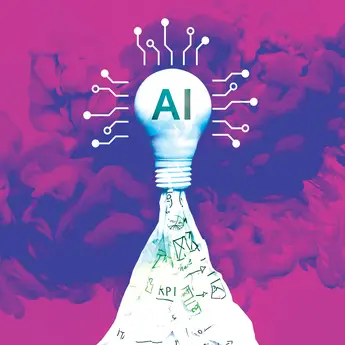Credit: Shutterstock / Marish
A new study measures the actual impact of robots on jobs. It’s significant.
Machines replacing humans in the workplace has been a perpetual concern since the Industrial Revolution, and an increasing topic of discussion with the rise of automation in the last few decades. But so far hype has outweighed information about how automation — particularly robots, which do not need humans to operate — actually affects employment and wages.
The recently published paper, “Robots and Jobs: Evidence from U.S. Labor Markets," by MIT professor and Boston University professor Pascual Restrepo, PhD ’16, finds that industrial robots do have a negative impact on workers.
The researchers found that for every robot added per 1,000 workers in the U.S., wages decline by 0.42% and the employment-to-population ratio goes down by 0.2 percentage points — to date, this means the loss of about 400,000 jobs. The impact is more sizable within the areas where robots are deployed: adding one more robot in a commuting zone (geographic areas used for economic analysis) reduces employment by six workers in that area.
To conduct their research, the economists created a model in which robots and workers compete for the production of certain tasks.
Industries are adopting robots to various degrees, and effects vary in different parts of the country and among different groups — the automotive industry has adopted robots more than other sectors, and workers who are lower and middle income, perform manual labor, and live in the Rust Belt and Texas are among those most likely to have their work affected by robots.
“It’s obviously a very important issue given all of the anxiety and excitement about robots,” Acemoglu said. “Our evidence shows that robots increase productivity. They are very important for continued growth and for firms, but at the same time they destroy jobs and they reduce labor demand. Those effects of robots also need to be taken into account.”
“That doesn't mean we should be opposed to robots, but it does imply that a more holistic understanding of what their effects are needs to be part of the discussion … automation technologies generally don't bring shared prosperity by themselves,” he said. “They need to be combined with other technological changes that create jobs.”
Industrial robots are automatically controlled, reprogrammable, multipurpose machines that can do a variety of things like welding, painting, and packaging. They are fully autonomous and don’t need humans to operate them. Industrial robots grew fourfold in the U.S. between 1993 and 2007, Acemoglu and Restrepo write, to a rate of one robot per thousand workers. Europe is slightly ahead of the U.S. in industrial robot adoption; the rate there grew to 1.6 robots per thousand workers during that time span.
Improvements in technology adversely affect wages and employment through the displacement effect, in which robots or other automation complete tasks formerly done by workers. Technology also has more positive productivity effects by making tasks easier to complete or creating new jobs and tasks for workers. The researchers said automation technologies always create both displacement and productivity effects, but robots create a stronger displacement effect.
Acemoglu and Restrepo looked at robot use in 19 industries, as well as census and American Community Survey data for 722 commuting zones, finding a negative relationship between a commuting zone’s exposure to robots and its post-1990 labor market outcomes.
Adding one robot to a geographic area reduces employment in that area by six workers.
Between 1990 and 2007, the increase in robots (about one per thousand workers) reduced the average employment-to-population ratio in a zone by 0.39 percentage points, and average wages by 0.77%, compared to commuting zones with no exposure to robots, they found. This implies that adding one robot to an area reduces employment in that area by about six workers.
But what happens in one geographic area affects the economy as a whole, and robots in one area can create positive spillovers. These benefits for the rest of the economy include reducing the prices of goods and creating shared capital income gains. Including this spillover, one robot per thousand workers has slightly less of an impact on the population as a whole, leading to an overall 0.2 percentage point reduction in the employment-to-population ratio, and reducing wages by 0.42%. Thus, adding one robot reduces employment nationwide by 3.3 workers.
In a separate study of robot adoption in France, Acemoglu and his co-authors found that French manufacturing firms that added robots became more productive and profitable, but that increases in robot use led to a decline in employment industrywide.
Disproportionate impacts
The impact of robots varies among different industries, geographic areas, and population groups. Unsurprisingly, the effect of robots is concentrated in manufacturing. The automotive industry has adopted robots more than any other industry, the researchers write, employing 38% of existing robots with adoption of up to 7.5 robots per thousand workers.
The electronics industry employs 15% of robots, while plastics and chemicals employ 10%. Employees in these industries saw the most negative effects, and researchers also estimate negative effects for workers in construction and retail, as well as personal services.
While the automotive industry adopted robots at a quicker pace and to a greater degree than other sectors, that industry did not drive the study’s results. The impact of robots was consistent when that industry was taken out of the equation, the researchers write.

AI Executive Academy
In person at MIT Sloan
Register Now
Robots are most likely to affect routine manual occupations and lower and middle class workers, and particularly blue-collar workers, including machinists, assemblers, material handlers, and welders, Acemoglu and Restrepo write. Both men and women are affected by adoption of robots, though men slightly more. For men, impacts are seen most in manufacturing jobs. For women, the impacts were seen most in non-manufacturing jobs.
Robots negatively affect workers at all education levels, though workers without college degrees were impacted far more than those with a college degree or more. The researchers also found robot adoption does not have a positive effect on workers with master’s or advanced degrees, which could indicate that unlike other technology, industrial robots are not directly complementing high-skill workers.
Some parts of the United States saw relatively small adoption of robots, while in other states, including Kentucky, Louisiana, Missouri, Texas, and Virginia, robots have been adopted more along the order of two to five robots per thousand workers. In some parts of Texas, that number goes up to five to 10 per thousand workers, the researchers found. Detroit was the commuting zone with the highest exposure to robots.
Overall, robots have a mixed effect: replacing jobs that relatively high-wage manufacturing employees used to perform, while also making firms more efficient and more productive, Acemoglu said. Some areas are most affected by the mixed impact of robots. “In the U.S., especially in the industrial heartland, we find that the displacement effect is large,” he said. “When those jobs disappear, those workers go and take other jobs from lower wage workers. It has a negative effect, and demand goes down for some of the retail jobs and other service jobs.”
Acemoglu and Restrepo emphasize that looking at the future effect of robots includes a great deal of uncertainty, and it is possible the impact on employment and wages could change when robots become more widespread. Industries adopting more robots over the last few decades could have experienced other factors, like declining demand or international competition, and commuting zones could be affected by other negative shocks.
Related Articles
But the researchers said their paper is the first step in exploring the implications of automation, which will become increasingly widespread. There are relatively few robots in the U.S. economy today and the economic impacts could be just beginning.
Robotic technology is expected to keep expanding, with an aggressive scenario predicting that robots will quadruple worldwide by 2025. This would mean 5.25 more robots per thousand workers in the U.S., and by the researchers’ estimate, a 1 percentage point lower employment-to-population ratio, and 2% lower wage growth between 2015 and 2025. In a more conservative scenario, the stock of robots could increase slightly less than threefold, leading to a 0.6 percentage point decline in the employment-to-population ratio and 1% lower wage growth.
The economic crisis spurred by the COVID-19 pandemic will further exacerbate the good and bad impacts of robots and technology, Acemoglu said. “The good because we are really dependent on digital technologies. If we didn't have these advanced digital technologies, we wouldn't be able to use Zoom or other things for teaching and teleconferencing. We would not be able to keep factories going in many areas because workers haven't fully gotten back to work,” he said. “But at the same time, by the same token, this increases the demand for automation. If the automation process was going too far or had some negative effects, as we find, then those are going to get multiplied as well. So we need to take those into account.”
Read "Robots and Jobs: Evidence from U.S. Labor Markets"




